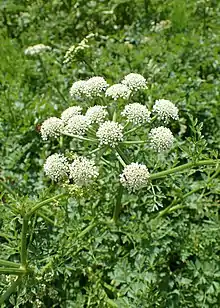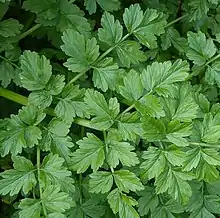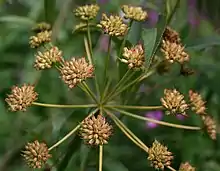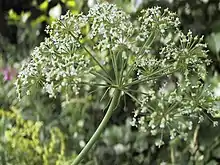Oenanthe crocata
Oenanthe crocata, hemlock water-dropwort (sometimes known as dead man's fingers) is a flowering plant in the carrot family, native to Europe, North Africa and western Asia. It grown in wet grassland and along river banks. All parts of the plant are extremely toxic and it has been known to cause human and livestock poisoning.
| Oenanthe crocata | |
|---|---|
 | |
| Scientific classification | |
| Kingdom: | Plantae |
| Clade: | Tracheophytes |
| Clade: | Angiosperms |
| Clade: | Eudicots |
| Clade: | Asterids |
| Order: | Apiales |
| Family: | Apiaceae |
| Genus: | Oenanthe |
| Species: | O. crocata |
| Binomial name | |
| Oenanthe crocata L. | |
Description
Hemlock water-dropwort is a robust hairless perennial growing up to 150 cm tall with hollow, cylindrical, grooved stems up to 1 cm across. The stems are often branched. The upper part of the roots are five or more obovoid, pale yellow, fleshy tubers up to 6 cm long, which exude yellowish fluid when cut that stains the skin.

The lower leaves are 3–4 times pinnate, triangular, with oval toothed leaflets 10–20 mm long, that are basally tapered to the stalk (cuneate). The upper leaves are 1–2 pinnate, with narrower lobes and a shorter petiole (leaf stalk). All the leaves are spirally arranged and have petioles that are slightly sheathing around the stem. The leaves have a characteristically deceptive smell of parsley or celery.[1] [2]
Like other species in the genus, hemlock water-dropwort has compound umbels, with 12–40 smooth rays (stalks), 3–8 cm long, which carry the smaller umbels. These rays are shorter than the stalk (peduncle) below, and they do not become thicker after flowering. At the base of the rays are about five bracts, which are linear to trifid in shape. These umbels are either terminal (at the top of the step) or lateral (in the leaf axils).

The small umbellules, which are 5–10 cm in diameter, have 6 or more bracteoles at their base and numerous flowers on short pedicels. The flowers are white, almost actinomorphic with five subequal petals, the outer ones being slightly larger. There are also five conspicuous sepals which are triangular, sharply pointed, and persistent. The terminal umbels have mostly bisexual flowers; the lateral ones have mostly male flowers. The flowers have five stamens and (if present) two styles, with an enlarged base forming a structure called a stylopodium. The cylindrical fruits are 4–6 mm long, with styles measuring 2 mm in length.[3][4]
This species usually flowers in June and July in northern Europe.[5]
Identification

Hemlock water-dropwort is easily separated from the other water-dropworts in Britain by its greater size, its broad, flat leaflets, and the long, thin bracts on the primary umbels. It is more likely to be confused with species in other genera, including perhaps cowbane or greater water-parsnip. The former has no bracts and latter has upper leaves which are just once pinnate, while hemlock water-dropwort always has at least ternate leaflets (divided into three parts).[3]
Taxonomy
Although hemlock water-dropwort has been recognised as a distinct plant for centuries, the modern definition was worked out by Artedius in the early 18th century, and the name was published by Linnaeus in 1753 in Species Plantarum.[6]
It has several synonyms (i.e. other authors have named the same plant, but the Linnaean name for it stands), including Phellandrium plinii Bubani (1899), Oenanthe macrosciadia Willk. (1852) and O. gallaecica Pau & Merino (1904). A full list can be found in the Synonymic Checklists of the Plants of the World.[7]
It has no subspecies, but numerous varieties have been named, none of which is in common use today.[8]
There are no recorded hybrids.[9]
Its chromosome number is 2n = 22 (based on British specimens).[3]
Distribution and status
It has a very Atlantic distribution in Europe, from the coast of the Netherlands south to Portugal and Spain, rapidly becoming rare inland. It is common again in Corsica and Sardinia but otherwise only sparsely distributed around the Mediterranean east to Syria and southwards to Morocco. It is perhaps most common in Britain and Ireland, where it is widespread throughout, even in inland locations.[10][11]
Habitat and ecology
It grows in shallow freshwater in streams, marshes, lakes, ponds, canals, wet woodland and on riverbanks as well as in rocky coastal streams.[2] The plant is usually a calcifuge, and as a lowland species it nearly always occurs below 300 m.[2]
Toxicity
The toxic principle in the plant is oenanthotoxin, a polyunsaturated higher alcohol that is a potent convulsant and resembles cicutoxin, the toxic constituent in hemlock. The plant is very poisonous to humans and livestock and can cause imminent death if poisoning is left untreated after ingestion. Symptoms in livestock include increased salivation, dilated pupils, respiratory distress, and convulsions. Cattle poisoning from this plant occurs sporadically. For example, several cases were reported during the 1995 drought in the West Country, England. Due to the shortage of grass in the fields, the cattle were driven to graze by ditches where hemlock water-dropwort grew.[12] More occasional instances of human poisoning have also been reported, in which the plant roots consumed were mistaken for wild parsnip and the leaves for wild celery.[12][13] Symptoms in humans include nausea, vomiting, seizures, hallucinations, ataxia, and respiratory distress.[14][15]
The roots are the most toxic part of the plant, with toxin concentrations being highest in winter and spring.[14] Boiling the roots seems to both lessen the severity of the symptoms and prolong the delay after which they appear following ingestion.[13]
Uses and in culture
Scientists at the University of Eastern Piedmont in Italy wrote that they had identified Oenanthe crocata as the plant responsible for producing the sardonic grin.[16][17] This plant is a possible candidate for the "sardonic herb", which was a neurotoxic plant referred to in ancient histories. It was purportedly used for the ritual killing of elderly people and criminals in Nuragic Sardinia. The subjects were intoxicated with the herb and then dropped from a high rock or beaten to death.[18][19]
The essential oils from the seeds of O. crocata have been shown to have moderate antibacterial effect against Streptococcus faecalis and Bacillus lentus.[20] The oils are also anti-inflammatory, antioxidant and anti-fungal (esp. against Cryptococcus neoformans), and they have been suggested for use in counteracting inflammatory diseases.[21]
References
- Rose F. 2006. The Wildflower Key. Warne.
- Newman J. 2005. CEH Information Sheet 31: Oenanthe crocata (Hemlock Water-Dropwort).
- Tutin, T.G. (1980). Umbellifers of the British Isles. London: Botanical Society of the British Isles.
- Sell, Peter; Murrell, Gina (2009). Flora of Great Britain and Ireland, vol 3. Cambridge: Cambridge University Press.
- Gibbons B, Brough P. 2008. Guide to Wildflowers of Britain and Northern Europe. Philips
- Constance, L. (1971). History of the classification of Umbelliferae (Apiaceae) in Heywood, V. H. (ed.) The Biology and Chemistry of the Umbelliferae. London: Academic Press. pp. 1–11.
- Hassler, M. "Synonymic Checklists of the Vascular Plants of the World".
- Global Biodiversity Information Facility. "Oenanthe crocata L." Retrieved 27 April 2022.
- Stace, C.A. (1975). Hybridization and the Flora of the British Isles. London: Academic Press. ISBN 0-12-661650-7.
- Streeter D, Hart-Davis C, Hardcastle A, Cole F, Harper L. 2009. Collins Wildflower Guide. HarperCollins.
- Global Biodiversity Information Facility. "Oenanthe crocata L." Retrieved 2 May 2022.
- Mabey R. 1996. Flora Britannica. Random House.
- Downs C, Philips J, Ranger G, Farrel L. 2002. A hemlock water-dropwort curry: a case of multiple poisoning. Emergency Medical Journal 19: 472 – 473.
- Ball MJ, Flather ML, Forfar JC. 1987. Hemlock water dropwort poisoning. Postgraduate Medical Journal 63: 363 – 365.
- Brown, Mark (1 November 2021). "Public told to avoid potentially deadly plant washed up on Cumbria beaches". The Guardian.
- News Scan Briefs: Killer Smile, Scientific American, August 2009
- G. Appendino; F. Pollastro; L. Verotta; M. Ballero; A. Romano; P. Wyrembek; K. Szczuraszek; J. W. Mozrzymas & O. Taglialatela-Scafati (2009). "Polyacetylenes from Sardinian Oenanthe fistulosa: A Molecular Clue to risus sardonicus". Journal of Natural Products. 72 (5): 962–965. doi:10.1021/np8007717. PMC 2685611. PMID 19245244.
- Appendino, Giovanni; Pollastro, Federica; Verotta, Luisella; Ballero, Mauro; Romano, Adriana; Wyrembek, Paulina; Szczuraszek, Katarzyna; Mozrzymas, Jerzy W.; Taglialatela-Scafati, Orazio (2009-05-22). "Polyacetylenes from Sardinian Oenanthe fistulosa: A Molecular Clue to risus sardonicus". Journal of Natural Products. 72 (5): 962–965. doi:10.1021/np8007717. ISSN 0163-3864. PMC 2685611. PMID 19245244.
- Owen, James (2009-06-02). "Ancient Death-Smile Potion Decoded?". National Geographic News. Archived from the original on 2009-09-18. Retrieved 2009-10-18.
- Bonsignore L, Casu L, Loy G, Deidda D, Genco F. 2004. Analysis of the essential oil of Oenanthe crocata L. and its biological activity. Journal of Essential Oil Research, 16(3): 266-269.
- Valente J, Zuzarte M, Gonçalves MJ, Lopes MC. Cavaleiro C, Salgueiro L, Cruz MT. 2013. Antifungal, antioxidant, and anti-inflammatory activities of Oenanthe crocata L. essential oil. Food and chemical toxicology 62: 349-354.